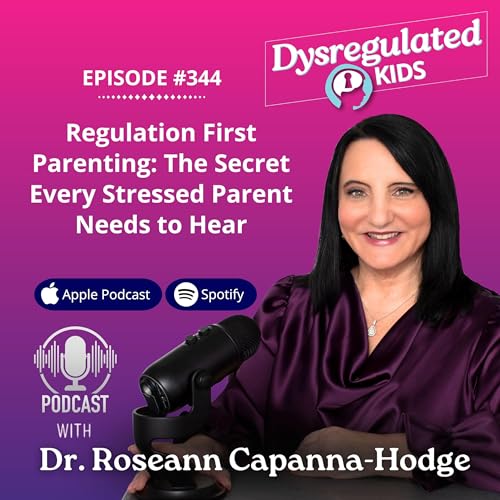
344: Regulation First Parenting: The Secret Every Stressed Parent Needs to Hear
No se pudo agregar al carrito
Add to Cart failed.
Error al Agregar a Lista de Deseos.
Error al eliminar de la lista de deseos.
Error al añadir a tu biblioteca
Error al seguir el podcast
Error al dejar de seguir el podcast
-
Narrado por:
-
De:
Parenting a dysregulated child can leave you drained and second-guessing yourself. You try connecting, you set boundaries—yet the meltdowns, backtalk, and big emotions just don’t stop. But here’s the truth: it’s not bad parenting—it’s a dysregulated brain. And there is a way forward.
In this episode, I’ll introduce Regulation First Parenting—a practical, science-backed approach that helps children calm their nervous systems so connection and teaching can actually stick. You’ll learn why traditional parenting advice often backfires, how co-regulation works, and what steps you can take today to bring more peace into your home.
Why does my child melt down after school even when I try to connect?
Many parents wonder, “Why does my child explode the minute they walk through the door?” You’re not imagining it. When kids are running on stress responses, connection without regulation falls flat. Their nervous system is in survival mode, and even the kindest validation can unintentionally make anxiety and distress worse.
That’s why regulation has to come first. Until the brain is calm, your child simply can’t access learning, connection, or even your love in the way you want them to.
- Regulation comes before connection. A dysregulated brain can’t learn or fully receive your love and guidance.
- Gentle parenting without boundaries fuels dysregulation. Endless empathy without calm structure leaves kids feeling more overwhelmed.
- Behavior is communication. Every meltdown is your child’s nervous system saying, “I need support, not punishment.”
When you shift to this Regulation First Parenting mindset, you stop spinning your wheels and begin giving your child the calm foundation they need to eventually learn self regulation skills, emotional awareness, and positive outcomes.
Want to stay calm when your child pushes every button?
Become a Dysregulation Insider VIP and get the FREE Regulation Rescue Kit—your step-by-step guide to stop oppositional behaviors without yelling or giving in.
Go to www.drroseann.com/newsletter and grab your kit today.
How can I help my child regulate their emotions in difficult moments?
Your child’s nervous system syncs with yours through co-regulation. When you stay calm, they can borrow your calm.Over time, this builds their ability to self regulate.
Tips for practicing co regulation:
- Model calm stress responses. Use deep breathing, softer facial expressions, or a gentle rhythm in your voice.
- Pause before reacting. Even a few seconds of self reflection helps you manage your own triggers.
- Practice mindfulness. A deep breath or butterfly tapping resets your body so you can respond instead of react.
- Use the traffic light model. Using this model helps parents feel less overwhelmed because it gives you a clear roadmap for when to pause, when to support, and when to guide your child’s behavior.
- Red = stop talking. When your child is in full meltdown, their brain is in survival mode. This is the time to focus on your own calm, not correction.
- Yellow = stress is lowering. As their body begins to settle, your co-regulation helps them feel safe enough to start regaining control.
- Green = learning can happen. Once calm returns, your child’s prefrontal cortex is back online. This is when connection and teaching finally stick.
Why do discipline and sticker charts...


